
Home - Search - Browse - Alphabetic Index: 0- 1- 2- 3- 4- 5- 6- 7- 8- 9
A- B- C- D- E- F- G- H- I- J- K- L- M- N- O- P- Q- R- S- T- U- V- W- X- Y- Z
IRBM
Intermediate range ballistic missile
Subtopics
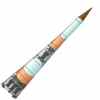 |
G-2 The G-2 design objective was to create the first IRBM - to deliver a 1000 kg payload over a 2500 km range. The missile would use three V-2 derived engines with a total thrust of 100 metric tons. A variety of alternate configurations (R-12A through R-12K) were considered by the German team in Russia. These included parallel and consecutive staging, gimbaled motors, and other innovations. The R-12K was particularly interesting because it represented a concept later used on the US Atlas missile - jettisoning of the two outboard engines at altitude to significantly improve range. The G-2 was given the secret designation R-6 and overt designation R-12 by the Russians. |
 |
R-3 Korolev 3000 km range intermediate range ballistic missile. Developed April 1947 to 1949 before cancellation. |
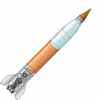 |
G-1 Russian intermediate range ballistic missile. The G-1, an improved 600 km range version of the V-2 missile, was the first design produced by Groettrup's German engineering team after they had been moved to Russia. A Soviet state commission found in 1948 that it was superior to Korolev's R-2 concept. Nevertheless the R-2 was put in production instead. |
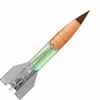 |
Super V-2 French intermediate range ballistic missile. Developed version of German A9 studied by the German team in France in 1946-1948. Cancelled as too ambitious, but led to the Veronique of the 1950's, the Diamant of the 1960's, and the Ariane space booster of 1979-2003. |
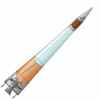 |
G-4 Russian intermediate range ballistic missile. The G-4 was designed by the Groettrup German team in the Soviet Union in competition with Korolev's R-3. Rocket chief Ustinov informed Groettrup of the requirement on 9 April 1949: to deliver a 3000 kg atomic bomb to a 3000 km. This requirement meant a massive improvement over existing V-2 technology. The G-4 was evaluated against Korolev's R-3 on 7 December 1949 - and the G-4 was found to be superior. Neither ended up in production, but the design concepts of the G-4 led directly to Korolev's R-7 ICBM (essentially a cluster of G-4's or R-3A's) and the N1 superbooster. Work on the G-4 continued through 1952. |
| R-2e Russian intermediate range ballistic suborbital launch vehicle. The R-2E prototype tested technological innovations planned for the production R-2 missile. These included use of an integral fuel tank and a separable warhead. |
 |
R-2 Russian intermediate range ballistic missile. The Soviet R-2 ballistic missile was developed in 1947-1953, nearly in parallel with the R-1 from which it derived. It incorporated many detailed improvements, had double the range of the R-1 and V-2, and was equipped with a deadly radiological warhead. The ethyl alcohol used in the V-2 and R-1 was replaced by methyl alcohol in the R-2, eliminating the problem of the launch troops drinking up the rocket fuel. Versions of the R-2 for suborbital manned flight were studied by Korolev in 1956-1958, but it was decided instead to move directly to orbital flights of the Vostok. However some equipment tested on the R-2 found its way onto canine flights of Sputnik and Vostok. The R-2 design was transferred to China in 1957 to 1961, providing the technical basis of the Chinese rocket industry. |
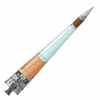 |
R-3A Russian intermediate range ballistic missile. So much new technology was involved for the R-3 that it was deemed necessary to build an R-3A intermediate experimental rocket, based on the R-2. This would be flown to test new construction methods, guidance systems, and high energy propellants. The R-3A was specified in 1949 to have a 900 to 1000 km range with a payload of 1530 kg; an unfueled mass of 4100 kg; 20,500 kg of propellants; and a lift-off thrust of 40 metric tons. The R-3A could also serve as a prototype for a more modest IRBM. Flight tests of the R-3A were scheduled for October 1951. |
| R-2R Russian intermediate range ballistic missile. |
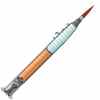 |
R-5 Yangel intermediate range ballistic missile. The R-5 was the first Soviet missile to be armed with a nuclear warhead, the first for which the new southern facility at Dnepropetrovsk took over full design and production responsibility. It was also the end of the road in being the ultimate extrapolation of German V-2 technology. Later missiles of both Yangel and Korolev would use other propellants and engine designs. |
 |
R-5M Russian intermediate range ballistic missile. The R-5M was the first Soviet missile to be armed with a nuclear warhead, and the first to launch a live nuclear warhead in test. The technical characteristics were virtually the same as those of the R-5 basic model, except for an increase in the propellant load. 48 launchers were deployed from 1956 to 1968, tipped with nuclear warheads of 80 kiloton, 300 kiloton, or 1 megaton. |
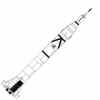 |
Jupiter IRBM American intermediate range ballistic missile. The Jupiter IRBM was developed for the US Army. By the time development was complete, the mission and the missile was assigned to the US Air Force, which had its own nearly identical missile, the Thor. Jupiters were stationed in Turkey and Italy in the early 1960's, but withdrawn in secret exchange for the withdrawal of Soviet R-5 missiles from Cuba. The Jupiter was used as the first stage of the relatively unsuccessful Juno II launch vehicle, and proposed for the Juno III and Juno IV. Jupiter tooling and engines were used to build the much larger Juno V / Saturn I launch vehicle. |
 |
DF-1 Chinese version of Soviet R-2. |
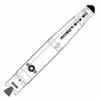 |
Thor American liquid propellant intermediate range ballistic missile, developed by Douglas in 1956-1958. 60 deployed to Britain in 1958-1962. The basis for a family of Thor and Delta space launch vehicles, remaining in production into the 2010's. |
| R-2A Russian intermediate range ballistic suborbital launch vehicle. The R-2A was designed for scientific research at altitudes of up to 200 km, including properties of the atmosphere from 150-200 km; ultraviolet observations of the sun; recovery of animals from flights to 200 km altitude; and study of the ionosphere at altitudes of 150-200 km. |
 |
R-12 Ukrainian intermediate range ballistic missile. The R-12 was the first operationally effective intermediate range ballistic missile, the first Soviet missile deployed with a thermonuclear warhead, and the first mass-produced missile in history. 2,300 of the storable propellant rockets were built and deployed in both mobile and silo-based versions for thirty years, from March 1959 to June 1989. It was a primary element in the Soviet deterrent threatening Western Europe and China throughout the Cold War. Deployment of R-12's to Cuba in 1962 precipitated the Cuba Missile Crisis. |
 |
R-5A Russian intermediate range ballistic missile. Vertical launch version of the R-5 missile for geophysical experiments retaining the nose cone of the IRBM, but equipped with a parachute recovery system. Experiments carried included solar ultraviolet spectroscopes, mass spectrometers for atmospheric composition studies, and capsules carrying dogs for zero-gravity biologically research. |
 |
Juno II (3) American intermediate range ballistic missile. Three stage version consisting of 1 x Jupiter + 1 x Cluster stage 2 + 1 x Cluster stage 3 |
| R-12U Ukrainian intermediate range ballistic missile. Universal version of the R-12U, for pad-launch or from the 'Dvina' silo complex. |
 |
RT-1 The RT-1 (RT = rocket, solid in Russian) was the first large Soviet solid propellant ballistic missile. It was developed and tested in 1959-1963, but no production was undertaken due to its poor performance. |
 |
DF-2 First Chinese IRBM, a single stage missile with the objective of carrying a 1500 kg warhead to Japan. The starting point for the design were R-12 construction drawings and a single exemplar of the missile provided by the Soviet Union prior to the break with Moscow in 1960. Following protracted development the design was accepted by the Chinese military for service in 1970. |
 |
R-5V Russian intermediate range ballistic missile. Vertical launch version of the R-5 missile for geophysical experiments under the Vertikal international program, equipped with a spherical re-entry capsule and a parachute recovery system. A wide range of international astrophysics and geophysics instruments were carried. |
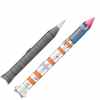 |
R-14 Ukrainian intermediate range ballistic missile. The R-14, with a range of 3600 km, was the only missile of that range class to be fielded. A key element in the Cuba missile crisis, it thereafter was part of the nuclear deterrent targeted at NATO and China. Built in relatively limited numbers by Soviet standards, it was perhaps more important as the basis for the first stage of the R-16 ICBM and the Kosmos-3 launch vehicle. The latter continued in use into the 21st Century. |
| Jupiter Mercury American intermediate range ballistic missile. Version of Jupiter IRBM designed for launch of Mercury manned capsules on long suborbital flights. Cancelled early in the program, with the decision being to proceed from Mercury Redstone suborbital flights directly to Mercury Atlas orbital missions. |
 |
Pershing US Army tactical missile, the first and only solid-fueled Medium Range Ballistic Missile deployed by the U.S. Army. It was in service for almost 30 years until all nuclear MRBMs were phased out and destroyed according to arms reduction treaties. |
| Pershing 1 American intermediate range ballistic missile. |
 |
DF-3 Chinese intermediate range ballistic missile. The DF-3 project began in 1964 with the objective of developing a nuclear-tipped missile capable of reaching the Philippines (earlier referred to as the DF-1). |
| 8K79 Russian intermediate range ballistic missile. Korolev 1961 design for a single stage military rocket. A competing missile was selected for the requirement. |
| Al Raid Egyptian intermediate range ballistic missile. |
 |
DF-4 Chinese intermediate range ballistic missile. Development of the DF-4 began in 1964 with the objective of fielding a ballistic missile capable of hitting Guam. The technical solution was to add a second stage to the DF-3 IRBM. |
 |
R-14U Russian intermediate range ballistic missile. Universal version, for pad-launch or from silo complex 'Chusovaya'. |
| R-5B Russian intermediate range ballistic missile. |
| 8K94 Ukrainian intermediate range ballistic missile. Unusual designation for the upper stages of another Yangel project - possibly reflecting design originally was stand-alone IRBM? |
| RT-25 Russian intermediate range ballistic missile. Decree 316-157 of 4 April 1961 authorized development of a family of solid propellant launch vehicles utilizing various combinations of three stages (the RT-2, RT-15, and RT-25). The RT-25 IRBM used the first and third stages of the RT-2 ICBM. M Yu Tsirulnikov at SKB-172 in Perm was responsible for development of the RT-25. However there was little interest in this variant and in 1963 further development was dropped. |
 |
Blue Streak British intermediate range ballistic missile. Cancelled 1960, but formed the basis for the ELDO Europa space launch vehicle in the late 1960's. |
 |
R-5 VAO Russian intermediate range ballistic missile. Vertical launch version of the R-5 missile for geophysical experiments using the High-Altitude Automatic Geophysical Station nose cone originally flown on the R-11, equipped with a parachute recovery system. . Experiments carried in the gyro-stabilised payload included solar ultraviolet spectroscopes and x-ray pinhole cameras. |
| DF-2A Chinese intermediate range ballistic missile. Extended-range version of DF-2. The missile featured reduced thrust, but 20% more range, and used autonomous gyroscopic guidance in place of the DF-2's radio system. |
| MMRBM American surface-to-surface ballistic missile, development started in 1961. Program cancelled in 1965. |
 |
RT-15 Russian intermediate range ballistic missile. The RT-15 IRBM used the second and third stages if the RT-2 ICBM. After protracted development in 1961-1970 with a range of alternative self-propelled mobile launchers, limited numbers ('few' to 19) of two types of launchers were deployed in 1970. The various transporters tested created confusion in the West (with designations SS-14 Scapegoat and Scamp being applied). |
| RT-20 Russian intermediate range ballistic missile. First and third stages of SS-13. Cancelled after 8 test firings. Claims to have been deployed briefly. |
 |
MSBS French intermediate range ballistic missile. |
| MSBS M112 French intermediate range ballistic missile. |
| MSBS M011 French intermediate range ballistic missile. |
| MSBS M012 French intermediate range ballistic missile. |
| MSBS M013 French intermediate range ballistic missile. |
| Pershing 1A American intermediate range ballistic missile. |
| 9K76 Russian intermediate range ballistic missile. |
| Temp-S The Temp-S was the first solid propellant tactical guided missile deployed in the USSR. It was designed by A D Nadiradze at NII-1 and formed the basis of subsequent designs leading to current modern Russian ICBM's. |
 |
Tochka Russian tactical short-range ballistic missile, deployed from 1976. |
| 15Zh45 Russian intermediate range ballistic missile. The missile was given a different DOD mod designation according to the number of warheads - Mod 1 for the single warhead version, Mod 2 for the triple warhead version. |
| MSBS M1 French intermediate range ballistic missile. Two stage vehicle consisting of 1 x SEP 901 + 1 x Rita I |
| MSBS M2 French intermediate range ballistic missile. Two stage vehicle consisting of 1 x SEP 904 + 1 x Rita II |
 |
Alfa Italy briefly flirted with the creation of an independent nuclear deterrent in the late 1960's. The Alfa project for an indigenous Italian submarine- and ship-launched ballistic missile was begun in 1971. Three Alfa test missiles with inert second stages were successfully launched in 1975-1976 from Salto di Quirra in Sardinia. The program was abandoned at this stage, when Italy and its neighbors ratified the nuclear proliferation treaty. |
 |
MSBS M20 French intermediate range ballistic missile. |
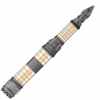 |
Pioner Russian intermediate range ballistic missile. Mobile solid propellant intermediate range multiple warhead ballistic missile. Seen as an enormous threat to NATO. 405 launchers deployed by 1987 when the missile was banned by the INF Treaty. |
| 9K714B Russian intermediate range ballistic missile. First flight 1974. |
| Oka Russian intermediate range ballistic missile. Tactical ballistic missile. SS-21 is Tochka SRBM mounted on a ZIL-375 transporter, while SS-23 is the same missile on an 8-wheeled TEL. |
 |
MSBS M4 French intermediate range ballistic missile. Submarine launched; MRV. Operational. 3 stage vehicle. |
| 15Zh53 Russian intermediate range ballistic missile. Development of a modernized version of the 15Zh45 IRBM began at the beginning of the 1980's. Flight trials either began in 1985 or were cancelled prior to their planned start in 1986. In 1988 the project was cancelled following the signature of the INF Treaty that banned intermediate range ballistic missiles. The missile (known to the Pentagon as both the SS-20 Mod 3 and the SS-28) would have had a range of 7500 km with a single warhead, or 5500 km with multiple warheads.Compared to the Pioner-U it used a larger launch container, a larger MIRV bus with greater accuracy. The KB Minsk Auto Factory developed a lighter, more comfortable crew cabin - important on constant field deployments. |
| Pioner UTTKh Russian intermediate range ballistic missile. The UTTKh model featured improved accuracy, range, and MIRV dispersal spread. It was not given a separate DoD 'mod' number. |
| Pershing 2 American intermediate range two-stage ballistic missile. Cancelled |
| Tochka-U Russian intermediate range ballistic missile. Improved version. |
| 9K76B Russian intermediate range ballistic missile. Initially designated SS-22 by DoD; redesignated SS-12M Scaleboard B |
 |
DF-21 Chinese two-stage solid propellant intermediate range ballistic missile. |
| DF-3A Chinese intermediate range ballistic missile. Modernized DF-3 with modest range increase. |
| Jericho II Israeli intermediate range ballistic missile. Tactical ballistic missile. Probably corresponds to first two stages of Shavit launch vehicle. |
 |
Al Hussein Iraqi modification of the R-17 that doubled the missile's range at the expense of more than halving the payload and accuracy. |
| Skorost Russian intermediate range ballistic missile. Soviet medium range ballistic missile, flown once but cancelled after being outlawed by INF Treaty. |
 |
DF-15 Chinese mobile solid propellant intermediate range ballistic missile. |
| Al Abbas Iraqi modification of the R-17 with an 800-km range, achieved by reducing warhead weight to 125 kg, and increasing propellant load by 30 percent . |
 |
Agni Indian intermediate range ballistic missile using a solid rocket motor developed from the first stage of the SLV-3 space launch vehicle. |
| Agni TD Indian intermediate range ballistic missile. Two stage test missile consisting of 1 x Agni (developed from first stage of the SLV-3 space launcher) + 1 x Prithvi upper stage. Development began in 1979 and fewer than 10 systems were produced. Flight tests in 1989-1994 before the program was terminated. |
| Nodong 1 North Korean intermediate range ballistic missile. Single stage vehicle, basis for Iranian Shahab 3 and Pakistani Ghauri. |
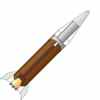 |
RSA-1 It is conjectured that this designation was assigned to an intermediate range single-stage ballistic missile consisting of the first stage of the RSA-3. Purported mission was to strike Cuban military concentrations from mobile launchers on South African territory. The rocket motor closely followed the design of the Israeli Jericho-2 first stage. |
 |
RSA-2 South African intermediate range ballistic missile. It is conjectured that this designation was assigned to an intermediate range ballistic missile consisting of the first and second stages of the RSA-3. Probably very similar to, or a licensed copy of the Israeli Jericho-2 missile. A third stage apogee kick motor was added to produce the RSA-3 space launcher. |
| Condor Argentinian intermediate range ballistic missile family, canceled under US pressure in 1991. |
| MGM-31D American intermediate range ballistic missile. Cancelled. Pershing II RR Reduced Range |
| MSBS M45 French intermediate range ballistic missile. Improved M-4. |
| Condor 2 Argentinian intermediate range ballistic missile. |
| MB/EE-600 Brazilian intermediate range ballistic missile. |
| Sky Horse Taiwanese intermediate range ballistic missile. |
| Shahab 4 Iranian missile said to be derived from Soviet-era R-12 intermediate range ballistic missile and having a 1400 kg payload. Was to have been the basis for an Iranian space launcher, then abandoned in 2003 in favor of development of the Shahab 3 for the role. |
| Ghauri Pakistani intermediate range ballistic missile. Derivative of North Korean Nodong. First fired April, 1998. Payload is about 700 kg. Managed by A Q Khan Research Laboratories. |
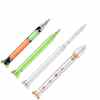 |
Shahab 3 Iranian intermediate range ballistic missile, evolved incrementally with Russian assistance from initial copy of North Korean Nodong 1 into a longer-range missile and the first stage of an orbital launch vehicle. Initial version began flight tests in 1998. |
 |
Shaheen 1 Pakistani mobile single-stage solid propellant intermediate range ballistic missile, a license-assembled Chinese DF-15. First flown in 1999. Entered service 2003. Project managed by Pakistan Atomic Energy Commission. |
| Agni 2 Indian intermediate range ballistic missile. Program revived in 1998, assumed to be nuclear warhead-capable. Known flight tests from 1999. |
| Badr-2000 Egyptian intermediate range ballistic missile. |
 |
Agni 1 Indian single-stage short range ballistic missile. |
| Al Aabed Iraqi intermediate range ballistic missile. Basis for the Tamouz space launch vehicle. Cancelled 1991. |
| Shaheen 2 Pakistani mobile two-stage solid propellant intermediate range ballistic missile developed by Pakistan, derived from Chinese technology. First flight March 9, 2004. Range extended from 2,500 km to 3,500 km during development. |
| Shaheen 3 Pakistani indigenous long-range missile, designed by Pakistani scientists using Chinese technology. Development cancelled in 2000. |
 |
Unha-1 North Korean intermediate range ballistic missile. Two-stage ballistic missile. First stage is 18 m long, second is 14 m long. |
| Agni 3 Indian intermediate range ballistic missile. Two stage missile consisting of 1 x Agni3 + 1 x Prithvi. |
| SS-1000 Brazilian intermediate range ballistic missile. |
Back to top of page
Home - Search - Browse - Alphabetic Index: 0- 1- 2- 3- 4- 5- 6- 7- 8- 9
A- B- C- D- E- F- G- H- I- J- K- L- M- N- O- P- Q- R- S- T- U- V- W- X- Y- Z
© 1997-2019 Mark Wade - Contact
© / Conditions for Use
